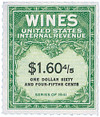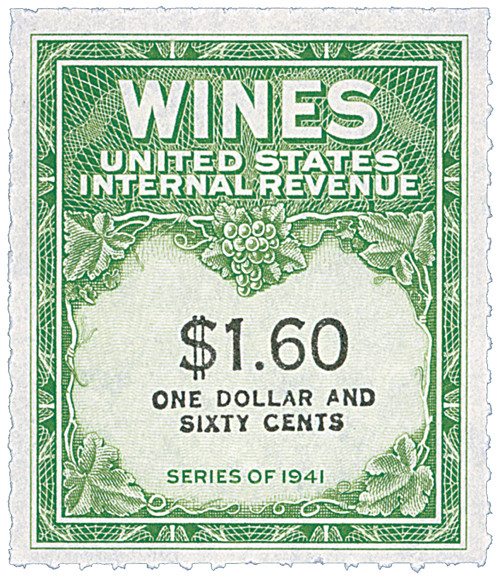
1951-54 $1.60 4/5 Cordials, Wines, Etc. Stamp,Engraved, yellow green & black
# RE196 - 1951-54 $1.60 4/5 Cordials, Wines, Etc. Stamp - Engraved, yellow green & black
$1.25 - $3.50
Wine revenue stamps showed the appropriate tax had been paid on the product. Strict regulations made it impossible for collectors to own them before 1954 – by law, the stamps could only be sold to proprietors of bonded wineries, store rooms and field warehouses.
Their use on bottles, railroad tankers and other containers was also heavily regulated. The stamps had to be affixed on the container securely in plain view, where they were exposed to weather and other harsh elements. Furthermore, winery proprietors were required to destroy the stamp when the containers were emptied.
Collectors were prohibited from owning Wine revenue stamps until 1949, and even then it was difficult or impossible to find mint copies. High face values also made it expensive for even wealthy collectors to purchase examples – in 1942, the $3,000 Wine revenue stamp cost the equivalent of $40,100 in today’s wages!
Additionally, some denominations were printed by the Bureau of Engraving and Printing, but never distributed by the Internal Revenue Service.
Wine revenue stamps showed the appropriate tax had been paid on the product. Strict regulations made it impossible for collectors to own them before 1954 – by law, the stamps could only be sold to proprietors of bonded wineries, store rooms and field warehouses.
Their use on bottles, railroad tankers and other containers was also heavily regulated. The stamps had to be affixed on the container securely in plain view, where they were exposed to weather and other harsh elements. Furthermore, winery proprietors were required to destroy the stamp when the containers were emptied.
Collectors were prohibited from owning Wine revenue stamps until 1949, and even then it was difficult or impossible to find mint copies. High face values also made it expensive for even wealthy collectors to purchase examples – in 1942, the $3,000 Wine revenue stamp cost the equivalent of $40,100 in today’s wages!
Additionally, some denominations were printed by the Bureau of Engraving and Printing, but never distributed by the Internal Revenue Service.












